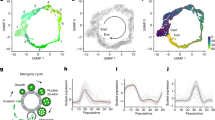Abstract
THE protein Sec4p plays an essential role at the final stage of the yeast secretory pathway and belongs to the ras superfamily of GTP-binding proteins1, more specifically to a branch that includes Yptlp in Saccharomyces cerevisiae and rab proteins in mammalian cells. GTP-binding proteins change conformation depending on whether GTP or GDP is bound2 and can thus act as a regulatory switch. The protein remains in its inactive, GDP-bound form until exchange of GTP for GDP allows it to stimulate a downstream effector. This interaction is curtailed by GTP hydrolysis. The rates of nucleotide exchange and GTP hydrolysis can be regulated by interaction with accessory proteins3. Although GDP dissociation stimulators (GDS) have been identified that act on members of the ras and rho branches of the superfamily, less is known regarding GDSs that act on members of the Sec4/Yptl/Rab subgroup. A preliminary characterization of a Rab3A GDP dissociation stimulating activity has been presented4. We report here the use of suppressor analysis to clone a gene, dss4, encoding a 17K protein that aids Sec4p action in vivo by functioning as a GDP dissociation stimulator.
This is a preview of subscription content, access via your institution
Access options
Subscribe to this journal
Receive 51 print issues and online access
$199.00 per year
only $3.90 per issue
Buy this article
- Purchase on Springer Link
- Instant access to full article PDF
Prices may be subject to local taxes which are calculated during checkout
Similar content being viewed by others
References
Salminen, A. & Novick, P. J. Cell 49, 527–538 (1987).
Milburn, M. V. et al. Science 247, 939–945 (1990).
Bollag, G. & McCormick, F. A. Rev. Cell Biol. 7, 601–632 (1991).
Burnstein, E. S. & Macara, I. G. Proc. natn. Acad. Sci. U.S.A. 89, 1154–1158 (1992).
Nair, J., Müller, H., Peterson, M. & Novick, P. J. Cell Biol. 110, 1897–1909 (1990).
Novick, P. J., Field, C. & Schekman, R. Cell 21, 205–215 (1980).
Kabcenell, A. K., Goud, B., Northup, J. & Novick, P. J. J. biol. Chem. 265, 9366–9372 (1990).
Studier, F. W., Rosenberg, A. H., Dunn, J. J. & Dubendorf, J. W. Meth. Enzym. 185, 60–89 (1990).
Burton, J., Roberts, D., Montaldi, M., Novick, P. & De Camilli, P. Nature (in the press).
Philippsen, P., Stotz, A. & Scherf, C. Meth. Enzym. 194, 169–181 (1991).
Sambrook, J., Fritsch, E. F. & Maniatis, T. in Molecular Cloning: A Laboratory Manual 2nd edn (Cold Spring Harbor Laboratory Press, New York, 1989).
Emanuel, J. T. et al. Molec. cell. Biol. 6, 2476–2481 (1986).
Christianson, T. W., Sikorski, R. S., Dante, M., Shero, J. H. & Hieter, P. Gene 110, 119–122 (1992).
Sanger, F., Nicklen, S. & Coulson, A. R. Proc. natn. Acad. Sci. U.S.A. 74, 5463–5467 (1977).
Lipman, D. & Pearson, W. Science 227, 1435–1441 (1985).
Holm, C., Meeks-Wagner, D., Fangman, W. & Botstein, D. Gene 42, 169–173 (1986).
Southern, E. M. J. molec. Biol. 98, 503–518 (1975).
Koerner, T. J., Hill, J. E., Myers, A. M. & Tzagoloff, A. Meth. Enzym. 194, 477–490 (1991).
Hunkapiller, M., Lujan, E., Oitrander, F. & Hood, L. Meth. Enzym. 91, 227–236 (1983).
Goud, B., Salminen, A., Walworth, N. C. & Novick, P. J. Cell 53, 753–768 (1988).
Guesdon, J. & Avrameas, S. J. Immun. Meth. 11, 129–133 (1976).
Marquart, D. W. J. Soc. ind. appl. Math. 11, 431–441 (1963).
Bowser, R. & Novick, P. J. J. Cell Biol. 112, 1117–1131 (1991).
Novick, P., Garrett, M., Brennwald, P. & Kabcenell, A. K. Meth. Enzym. 219, 352–362 (1992).
Walworth, N., Brennwald, P., Kabcenell, A., Garrett, M. & Novick, P. Molec. cell. Biol. 12, 2017–2028 (1992).
Author information
Authors and Affiliations
Rights and permissions
About this article
Cite this article
Moya, M., Roberts, D. & Novick, P. DSS4-1 is a dominant suppressor of sec4-8 that encodes a nucleotide exchange protein that aids Sec4p function. Nature 361, 460–463 (1993). https://doi.org/10.1038/361460a0
Received:
Accepted:
Issue Date:
DOI: https://doi.org/10.1038/361460a0
This article is cited by
-
Nucleotide exchange via local protein unfolding—structure of Rab8 in complex with MSS4
The EMBO Journal (2006)
-
Structure of guanine-nucleotide-exchange factor human Mss4 and identification of its Rab-interacting surface
Nature (1995)
-
No exchange without receipt
Nature (1994)
-
Membrane targeting of the small GTPase Rab9 is accompanied by nucleotide exchange
Nature (1994)
-
Proteins regulating Ras and its relatives
Nature (1993)
Comments
By submitting a comment you agree to abide by our Terms and Community Guidelines. If you find something abusive or that does not comply with our terms or guidelines please flag it as inappropriate.



